Ancistrus: features, types and content
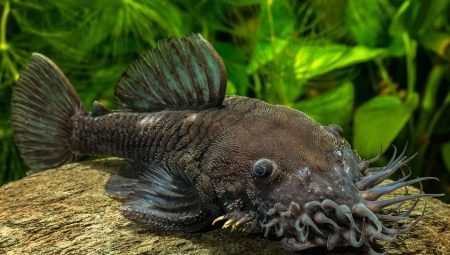
An aquarium is a closed ecosystem that lives to the fullest. And like any dwelling, it needs those who will keep the territory clean. Snails and various types of catfish are most suitable for the role of cleaners. The most famous among hobbyists are such unpretentious fish as catfish-ancystras.

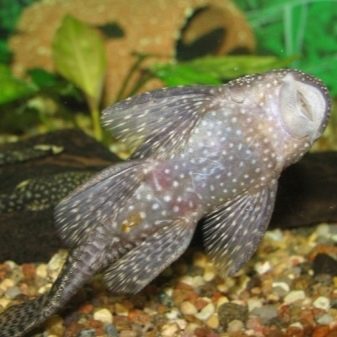
Description
Antsistrus cleaning fish have come to aquariums from fresh water bodies of South and Central America. Catfish of this species prefer fast-flowing rivers in the wild, but they can also be found in the stagnant waters of forest lakes and even in swamps with barrels of clear water. Somik-sticky is one of the most popular inhabitants of aquariums among both novice aquarists and professionals.
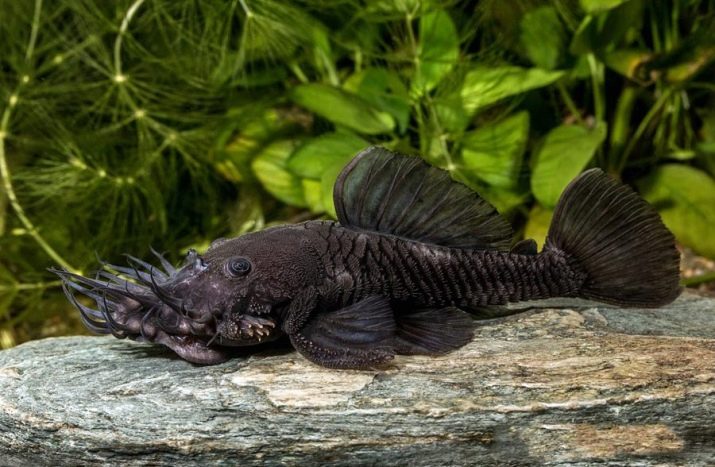
Ancistrus ordinary has a very original appearance. The body of the fish resembles an elongated drop, flattened at the top and bottom. The catfish is covered with multifaceted bone plates; the head is the widest part of the fish. A large dorsal fin, reminiscent of a fluttering cloth, in some individuals may be pressed against the back. The pelvic and pectoral fins are round and wide; the adipose fin is very small.
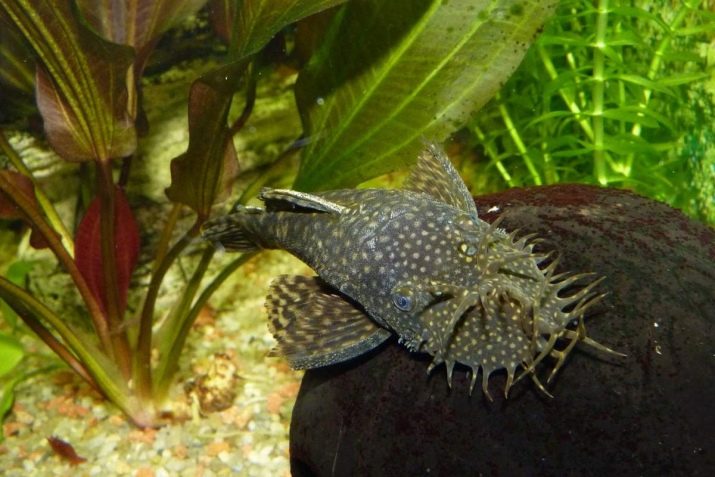
The catfish has a very interesting structure of the mouth, which is why it received the common name "catfish-sucker". The elongated lips, rounded lower mouth and the presence of horn-shaped suckers on the lips help the fish to stick to surfaces, preventing the flow of water from carrying the catfish away.
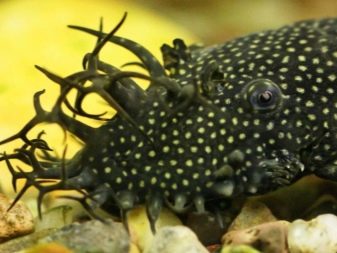
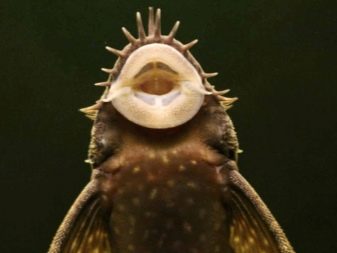
Ancistrus catfish are often called aquarium cleaners.
Due to the special structure of the mouth, they stick to stones at the bottom, glass of the aquarium, and other objects and eat what settles on them - this is how they clean the aquarium from excess debris and biological material.
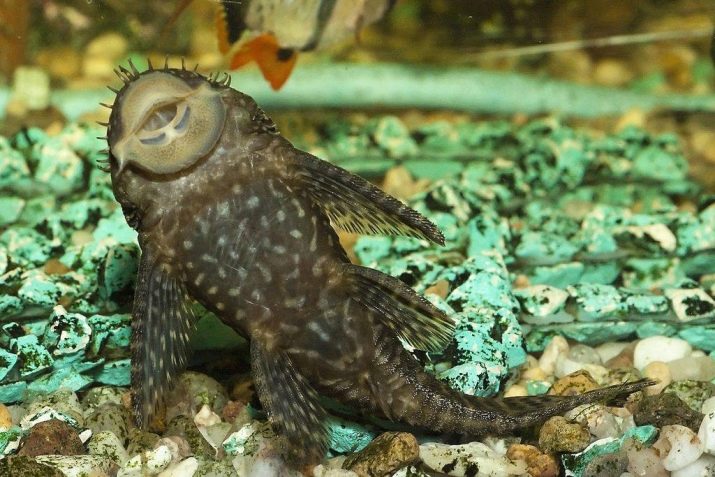
Varieties
In nature, there is a wide variety of ancistrus catfish, the size of which ranges from 20 to 195 mm. Some species of this fish live in aquariums.
Ordinary
Common ancistrus is also called blue ancistrus. This name is due to the fact that in young animals you can often find a blue shade of scales and a white edging on the fins. Adult catfish usually boast different shades of scales. – from yellowish gray to dark gray. White spots are chaotically located all over the body.

Veil
This species has highly developed fins, and when moving, they flutter like a veil in the wind. For this feature, the catfish got its name. The body color of the fish is mainly dark olive, with randomly located light specks. The movements are very smooth and resemble the flapping of wings, for which the subspecies received its second name - ancistrus dragonfly.
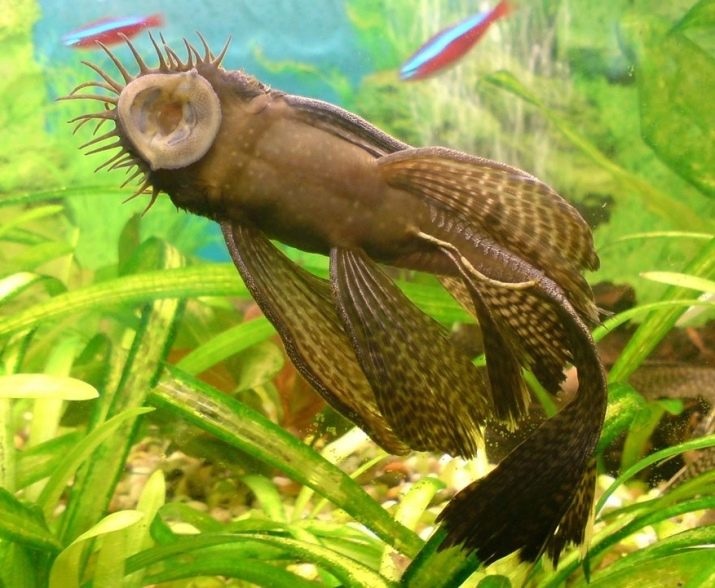
Star
Incredibly beautiful colors, reminiscent of the starry night sky, and became the source of the name of this species. The body of the fish is black or so dark in color with specks of pearl-white or bluish color that it feels like a piece of starry night is crawling along the bottom. Juveniles boast bluish edging of the dorsal and caudal fins. There are small spines on the first rays of the anterior fins of stellate ancistrus.
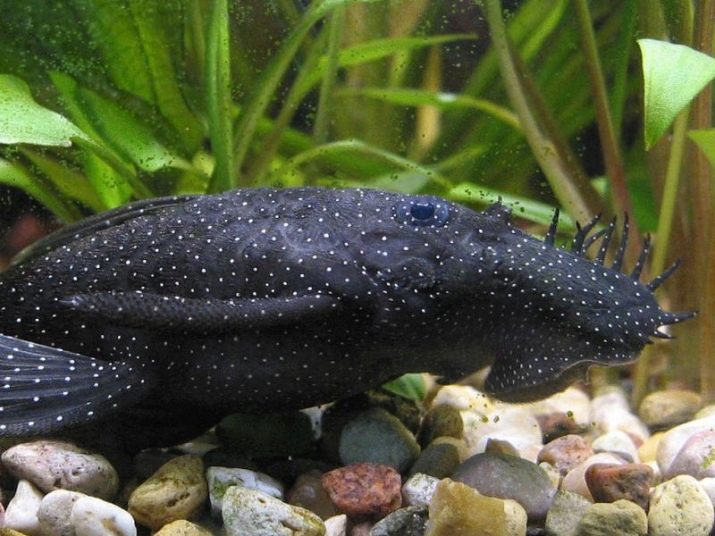
Star
Dark brown, almost black fish with small white or blue specks and thickened pectoral fins covered with thorny spines, very similar to the stellate ancistrus. The main difference will be the wide white edging of the fins, which is present throughout the fish's life. Also, stellar adhered have bone spines hidden at the base of the head. At the moment of danger, the fish spreads them apart in order to drive away enemies.
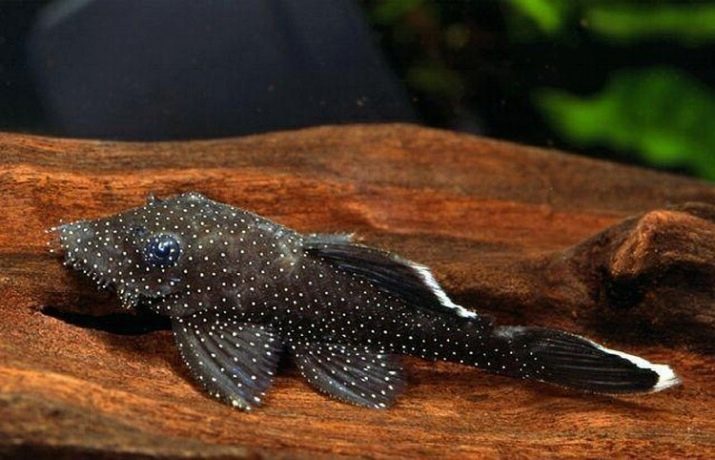
Diamond
One of the rarest numbered catfish is the L-184 diamond ancistrus. Outwardly, the fish resembles a stellated counterpart, differing from the latter in a more saturated black color with large bright white spots. The color does not change even in adult form.
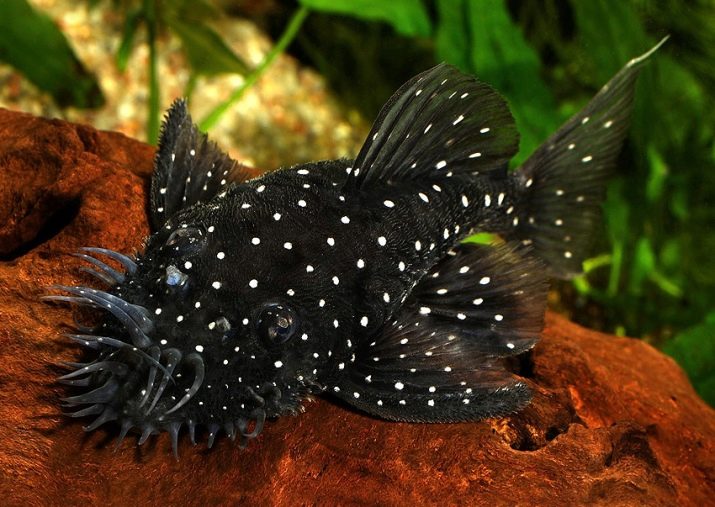
Red or Super Red
A little-known new variety developed by German breeders. It is characterized by incredibly bright brick-red or orange scales. Unlike other relatives, Red Ancistrus prefers to live an active life during daylight hours. Compared to other species, the body size of the fish is small, not exceeding 60 mm.
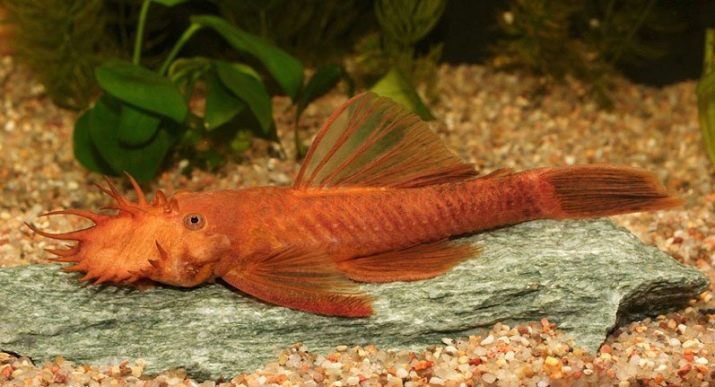
Golden albino
Ancistrus albino or golden ancistrus is a fish that has lost the pigmentation of its scales. Because of this, the body color has acquired a beautiful golden beige shade. The eyes are pinkish, which is a characteristic feature of albinos. Like albinos of other living things, the lifespan of such a fish is shorter than that of other species.

Yellow
The yellow catfish is one of the most well-known types of adherent, along with the common ancistrus. Outwardly, he strongly resembles an albino, differing from him only in the color of his eyes and a more saturated yellow calf color. The yellow catfish has ordinary eyes.
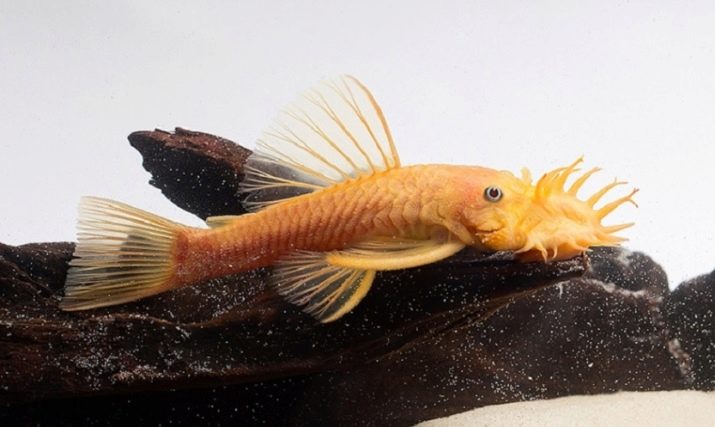
Leopard print
Gold leopard ancistrus is also called tortoiseshell or reddish brown. The fish got its name because of its beautiful leopard color. In fry, dark brown spots are scattered over the orange-red body. With age, the body color of the fish changes to golden yellow with pronounced dark spots. The breed was bred artificially and belongs to the numbered species. The official name of the catfish variety is LDA-016.
If the leopard ancistrus has spots of brown and gray on its body, then this color option is called tricolor or brindle.
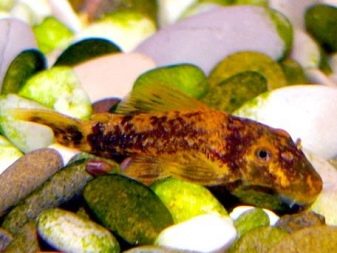

Differences from pterygoplicht
Newcomers to the aquarium hobby often confuse the ancistrus catfish with another type of chain mail catfish - the pterygoplicht fish. Despite the external similarity, these fish belong to different genera and in order to distinguish them, you need to know some of the characteristics of the fish.
- The color of the young and the adult does not differ in the pterygoplicht. Young ancistrus have a light edging on their fins, which disappears with age.
- A peculiar pattern is located on the body of the pterygoplicht: the older the individual, the less noticeable it is. Ancistrus has a variety of scale colors.
- In adult pterygoplichts, a mustache grows on the lower jaw. Ancistrus males boast many distinctive horns on the top of their heads.
- In pterygoplichts, sexual dimorphism is less pronounced.
- Unlike ancistrus, pterygoplicht is incapable of breeding in aquariums.
- Sticky catfish in aquariums live 7-8 years, pterygoplicht can live twice as long - about 15 years.
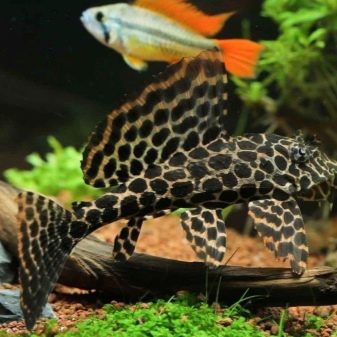
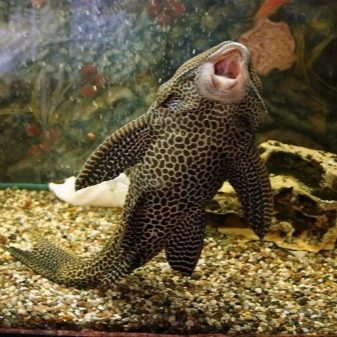
Compatibility
Catfish ancistrus are peaceful creatures. Due to the fact that they occupy the lower level, sucker fish get along in the same aquarium with almost any other type of fish. The only exceptions are breeding forms of phlegmatic and leisurely goldfish, as well as species of scaleless fish... These individuals can suffer, as catfish sometimes stick to their bodies, gnawing the unfortunate to the very bones.
It is also not recommended to settle aggressive cichlids and other territorial species in the same aquarium with catfish, otherwise constant fights will be inevitable.
The structure of the mouth cavity of ancistrus does not allow them to eat shrimp, therefore, it is quite possible for catfish and shrimp to live together.

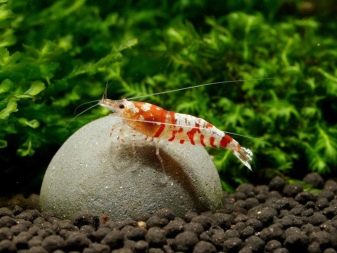
Conditions of detention
Ancistrus catfish are very unpretentious, even beginners can handle their content. Since the fish is very active, the aquarium must have a volume of at least 80 liters per 1 catfish. A comfortable temperature for ancistrus is + 22–26 ° C, but catfish can easily withstand drops from +18 to + 30 ° C (although it is better not to experiment this way, because such stress can be fatal for a fish).
In nature, ancistrus prefer slightly acidic water (6.0–7.3 pH), but in an aquarium they are less picky and survive in any conditions. The only essential factor for this fish is constantly clean and oxygenated water. For this, air filters are installed, the water is often changed.
Ancistrus catfish lead a predominantly twilight lifestyle, therefore constant bright lighting is contraindicated.
The aquarium should be set to calm, dim and dim lighting. In addition, the catfish themselves are activated in the evenings.
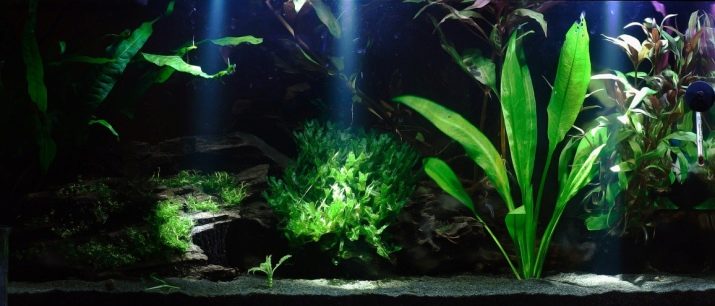
What and how to feed?
Catfish prefer plant food. In fact, the main food source for fish is algal fouling of the contents of aquariums (walls, decorations, ground).
But be that as it may, it is still necessary to feed the catfish. Most often, aquarists feed them with special food based on spirulina, designed specifically for chain mail (locaria) catfish. These feeds will give your fish all the trace elements it needs, including protein.
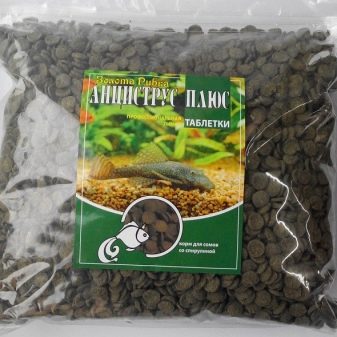
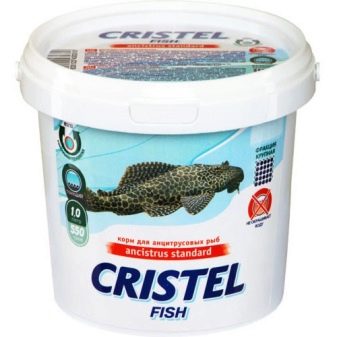
Ancistrus can be fed with boiled leaves of cabbage, nettle, lettuce; slices of zucchini, cucumbers, pieces of broccoli will help to diversify their diet.
The uneaten plant food should be removed from the aquarium, otherwise they will quickly spoil the water.
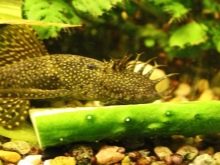
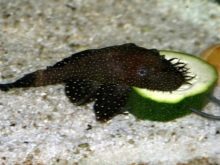

Aquarium decoration
When decorating an aquarium, it is worth using driftwood, artificial caves and grottoes. One of these decorative elements will be chosen by the catfish ancistrus as its house and will constantly live and guard in it. Fine gravel or sand should be used as a soil, laying it in a layer of 40-50 mm.
You can diversify the landscape of the aquarium with various plants, which can also become an additional source of vitamins and minerals for the fish. Experienced aquarists recommend planting algae in the aquarium with ancistrus. They grow rapidly and will be an essential addition to the catfish diet. For plants to develop normally, they need additional lighting during the daytime.
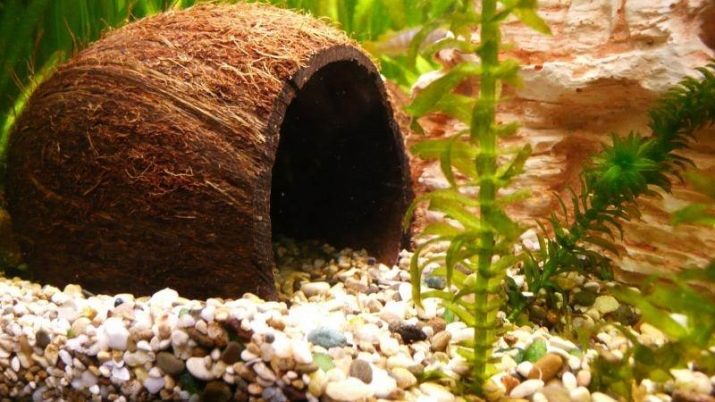
How to tell a male from a female?
The most characteristic feature that allows you to determine the sex of an adult is the presence of long horn-like growths on the upper jaw in males. This dimorphism becomes pronounced only closer to the age of puberty (about 1 year). Besides, catfish boys are sleeker and larger than females. Girls are smaller, with a more rounded abdomen. The horns on the noses of the females, if any, are short (about 1 mm long) and there are very few of them.
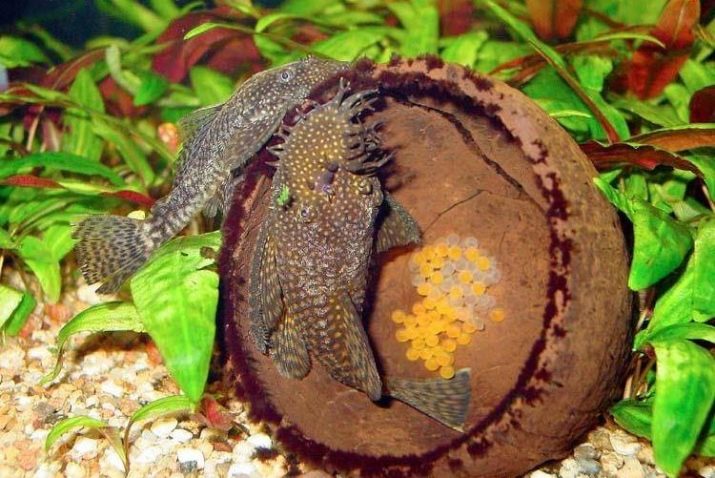
Reproduction
Ancistrus are unpretentious and can be easily bred even in common aquariums, which is fraught with other fish eating eggs. That's why immediately before breeding, it is worth planting a heterosexual couple chosen for breeding in a separate container. Catfish hide spawned eggs in various secluded places, for example, behind decorations, in decorative snags, and can be put into filters if they get there. Ancistrus caviar is yellow-red, rather large.
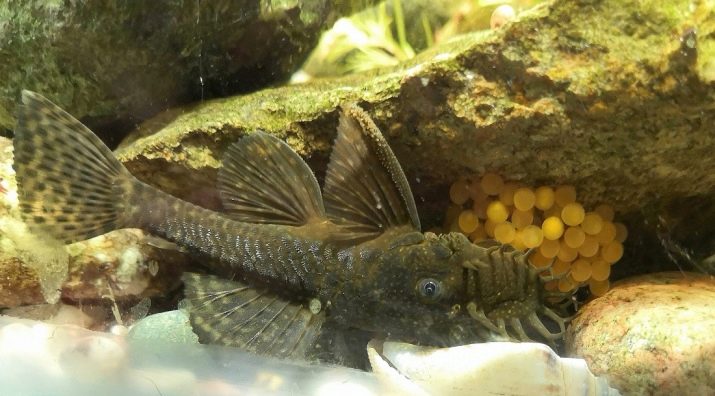
To preserve the number of hatched fry of suckling fish, catfish-producers are usually deposited in a special container - a spawning box. In order to bring the spawning time closer, stimulation is carried out: 2 parts of water from the general aquarium and 1 part of fresh water are poured into the spawning aquarium, then the ambient temperature is lowered by 2 ° C. Future parents are transplanted into a prepared container.
Once in the spawning grounds, the male begins preparation for spawning. He clears the place chosen for the nesting site - usually it is some kind of driftwood, crevice or pipe. The selection and cleaning of a future nest can take several days. After that, the process of courtship and spawning begins.
The female lays 30-200 eggs at night and sticks them in the place chosen by the male. After this, the female should be deposited as soon as possible.
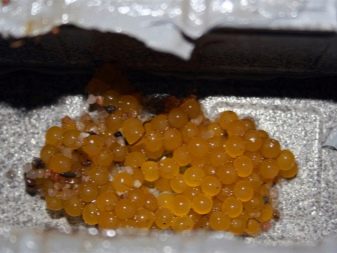
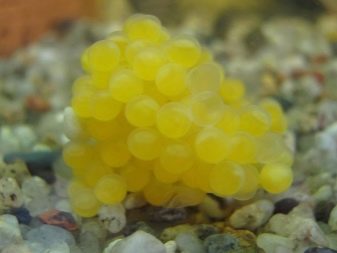
From this moment, the male begins to protect the offspring and shows aggression towards all fish, so the female may suffer.
After laying and until the fry begin to swim on their own, the male ancistrus takes care of the offspring. It cleans and aerates the eggs, driving away other fish from the nest, including the female that has laid eggs. The larvae hatched on the 5th day remain hanging on the nest in the form of a bunch for some time. This period lasts up to 7 days, until the yolk sac dissolves.
When the primary nutrients are fully absorbed, the fry begin to move independently. As soon as they become independent, the father is returned to his permanent territory.
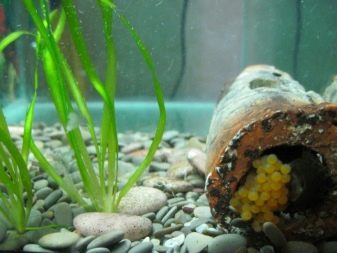

Ancistrus larvae, after hatching, feed on the contents of the yolk sacs from which they were born. Then they can be fed with special dry food. The most convenient way to use feed tablets is for catfish. It is advisable to provide the little ancistrus with abundant nutrition, at least 3 times a day.
In addition to nutrition, it is necessary to ensure a daily change of 20% of the water in the spawning grounds. With this care, the fry will reach adult size in six months, then they can be transplanted into an adult aquarium.
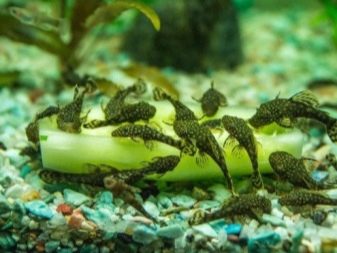

Possible problems
Although ancistrus are very unpretentious and rather peaceful creatures, keeping them can cause some problems. One of the main difficulties is that domestic water is limited in size. With a lack of free space, adult catfish can show aggression within their species to protect the territory.Their fights are rarely very fierce, but a stronger individual will not allow an opponent to eat calmly on their territory, which can lead to the death of a weak fish.
Another problem is the improperly chosen neighborhood. Sticky catfish are nocturnal creatures, they can "saddle" larger sleeping fish, for example, golden ones, and gnaw at their scales.
It happens that ancistrus can crawl into the filter tubes, which can lead to their death.
If the fish floats to the surface and begins to swallow air, it means that it is difficult for it to breathe. To solve this problem, it is necessary to increase the oxygen supply with the help of a compressor.
Ancistrus are susceptible to various diseases of the gastrointestinal tract, as well as viral or bacterial diseases associated with appearance. Worms can disturb the catfish. To avoid most of the problems, you should not start new fish into the general aquarium right away. They are kept in quarantine for several days and their condition is monitored. In case of manifestation of signs of the disease, it is worth contacting a specialist to choose a method of treatment.
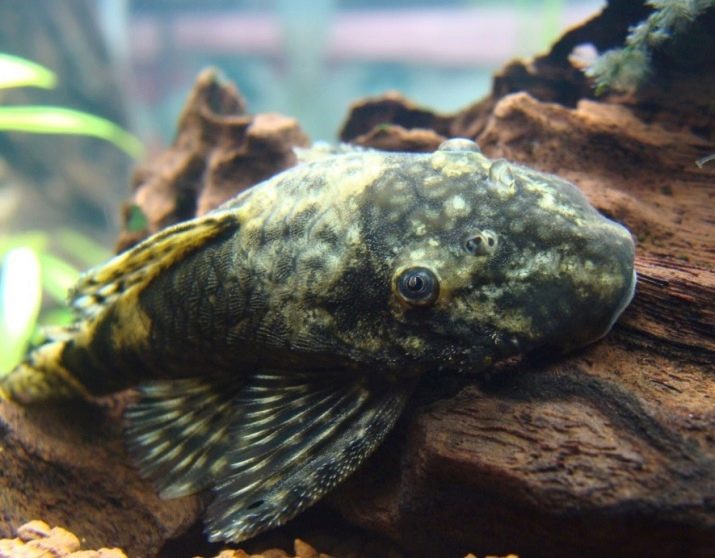
Advice
If you decide to introduce amazing cleaners into your home aquarium, then it is worth considering some of the nuances.
- In an aquarium with a volume of 150 liters, you can add no more than 4 fish.
- For each fish you need secluded spot (the house where she will live) and a favorite snag, which the catfish will gnaw.
- The water should be soft and slightly acidic, with a temperature of + 22-25 ° C. But some varieties of ancistrus prefer hard water.
- The aquarium must be equipped with a powerful aeration system.
- Sticky fish lead an active lifestyle at twilight, therefore, they do not need additional lighting. In the case of using the backlight, it is necessary to set equal light and dark periods with short twilight for half an hour.
- There should be a sufficient amount of green space in the aquarium.
- A weekly change of 25% of the total water volume is required.
Subject to these conditions, your catfish will be a healthy and happy long-liver.
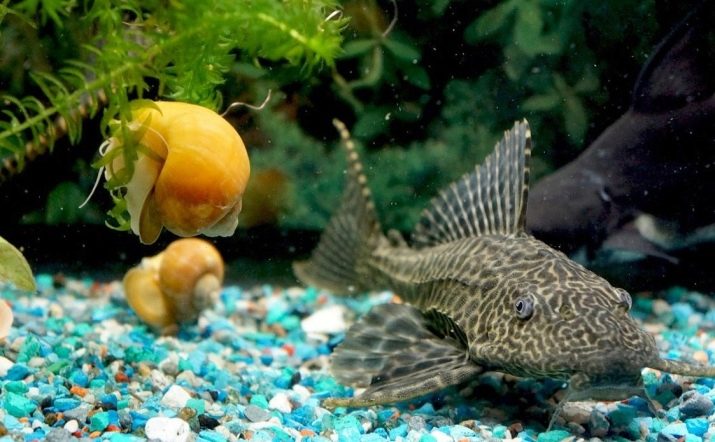
Review overview
If you ask those who have been keeping fish for a long time, then almost everyone will unanimously praise these unpretentious workers, fighters for the cleanliness of the aquarium. Everything about this fish suits the owners.
Of the shortcomings, they note the slow growth rate of the fish, the difficulty of determining the sex in babies and the love of hiding in a shelter during daylight hours, but at night the fish can crunch appetizing food. For some owners, adult catfish ate snails, despite the fact that the former seem to be vegetarians, and the latter are protected by shells. Ancistrus also dig up plants and dig underneath the bottom decorations.
In the bulk, ancistrus pleases with its appearance and playful behavior. It is happily kept in aquariums by both amateurs and professionals.

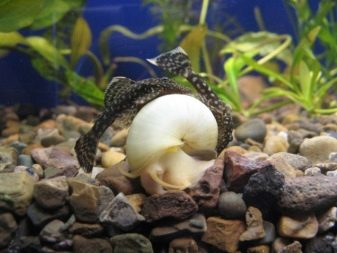
For more information on the ancistrus, see the next video.








